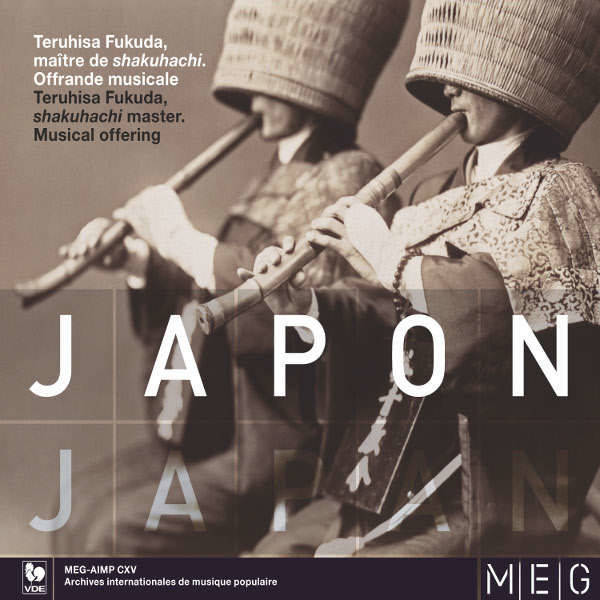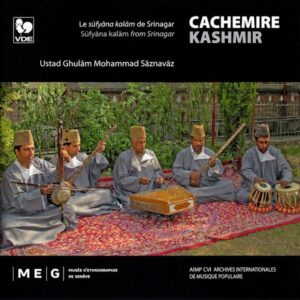Extraits / Excerpts
JAPAN : MUSICAL OFFERING OF A SHAKUHACHI MASTER – TERUHISA FUKUDA (ZEN MUSIC)
JAPON : OFFRANDE MUSICALE D’UN MAÎTRE DE SHAKUHACHI – JAPAN : MUSICAL OFFERING OF A SHAKUHACHI MASTER – TERUHISA FUKUDA – ZEN MUSIC (AIMP CXV, MEG Genève)
Ajikan – Echigo-sanya – Kokû – Reibo – Tamuke – Saji – Takiotoshi.
Teruhisa Fukuda, Maître de shakuhachi / Shakuhachi Master.
Collection AIMP CXV.
Teruhisa Fukuda is an eminent artist, master of the shakuhachi flute that he has been playing for over fifty years. He performs music belonging to the ancient traditions of Japan as well as contemporary works.
The shakuhachi is an end-blown bamboo flute with one dorsal and four frontal holes and a bevelled notch as mouthpiece. It is played using specific breathing and blowing techniques that allow to produce a large variety of sounds.
For this CD, Master Fukuda chose a series of seven pieces from a repertoire dating back to the seventeenth century. These were originally performed by monks belonging to the Fuke sect of zen Buddhism, who viewed their instrument as means for meditation. The seven pieces are destined to be played solo, in the spirit of zen.
Madeleine Leclair
Collection AIMP CXV, MEG Genève.
Link to our Albums AIMP Musique du Monde, Japon
Playing technique of the Shakuhachi
Playing the shakuhachi means concentrating and meditating on each of the sounds produced.
The shakuhachi covers a range of three octaves. It is played using specific breathing and blowing techniques that allow to produce a large variety of sounds through which the musician exteriorises his spirit : accents underscored by a lower-pitched glissando, ample irregular vibrati, fluctuating timbre, dynamic and pitch, explosive sounds, etc.
The muraiki is a technique characteristic of the shakuhachi. It consists in blowing along both sides of the mouthpiece in order to produce different sounds recalling the wind which may be light, gentle or strong. These sounds are said to express the sentiments of the itinerant Komusô.
The pieces
‘I chose to perform the following pieces in the spirit of a musical offering dedicated to my instrument because in playing the shakuhachi I am able to follow the path to illumination. I also wish to express my gratitude to all those who have been and will be part of my life.
These pieces belong to the repertoire of the Fuke sect of zen Buddhism dating back to the seventeeth century (Edo period).’
Ajikan
The term ajikan, ‘contemplating the letter A’, refers to the practice of one of the highest and most difficult forms of esoteric meditation, since the letter A is considered to refer to the root of all things in Buddhist philosophy. Belonging to the repertoire of so-called meditation music or honkyoku, Ajikan is said to originate from an older piece entitled Sashi or Saji.
Echigo-sanya
This piece is part of a set of pieces whose origin can be found in the komusô temple of the Echigo region. According to tradition, each komusô temple had an emblematic piece recalling the original and specific shakuhachi.
Kokû (‘Empty Sky’ or ‘Emptiness’)
Kokû is one of the most ancient and outstanding pieces of the honkyoku repertoire, together with Kyorei (‘Empty Bells’) and Mukaiji (‘Ocean and Mist’). They are said to have been created by a disciple of Kyochiku.
Reibo
Several pieces of the honkyoku repertoire carry the title Reibo. This term evokes the sound of the small bell of the monk Fuke who founded the sect of zen Buddhism to which the Komusô belong. This piece originates from the komusô temple of the Tôhoku region in northeastern Japan.
Tamuke (‘Offertory’)
This piece having a liturgical function is often performed during thanksgiving or rituals in homage to the dead.
Saji
The term saji or sashi may be written using various Chinese characters to denote as many meanings. The main ones are : ‘compassion of the Bodhisattva’, or ‘offering with a high degree of humility’. This piece thus echoes the title of this CD. There exist several versions. The one featured here is called Ifu-Saji.
Takiotoshi (‘Waterfall’)
It is said that a komusô temple was built near this waterfall which is located in the Izu area.
Teruhisa Fukuda
- Categories
- Interprets
- Booklet













